Samples of Equipment Found on British Rail
[ Back ]
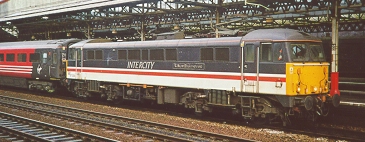 Many of the high speed intercity
passenger trains that ran in the overhead electrified territory
were powered by a single electric loco. This unit apparently has
plenty of power as it was able to accelerate 8 or more coaches
quite quickly. At the other end of the train would usually be found
a combination cab control/baggage car. At a glance, this car looked
like some of the diesel units, but it was missing the smoke and
noise.
Many of the high speed intercity
passenger trains that ran in the overhead electrified territory
were powered by a single electric loco. This unit apparently has
plenty of power as it was able to accelerate 8 or more coaches
quite quickly. At the other end of the train would usually be found
a combination cab control/baggage car. At a glance, this car looked
like some of the diesel units, but it was missing the smoke and
noise.
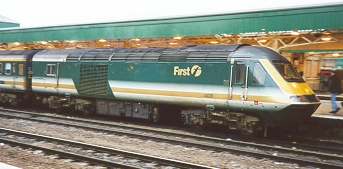 Diesel powered high speed intercity
passenger trains were usually powered by a unit at both ends of the
train. Even with two units, these trains didn't seem to pull out of
the stations as quickly as the electric trains.
Diesel powered high speed intercity
passenger trains were usually powered by a unit at both ends of the
train. Even with two units, these trains didn't seem to pull out of
the stations as quickly as the electric trains.
 Intercity trains run between major
cities at very high speeds. However, there were many "local" trains
running that maybe got to 60 or 70 mph and stopped much more often.
Most of these trains are MU self powered cars, some electric, some
diesel. This set is a Wales & West "Alphaline" train composed
of diesel powered cars. These train usually ran in two car consists
with a control cab at either end.
Intercity trains run between major
cities at very high speeds. However, there were many "local" trains
running that maybe got to 60 or 70 mph and stopped much more often.
Most of these trains are MU self powered cars, some electric, some
diesel. This set is a Wales & West "Alphaline" train composed
of diesel powered cars. These train usually ran in two car consists
with a control cab at either end.
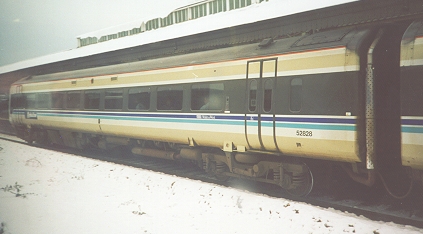 On our move
from London to Cardiff, it was quite cold and it had snowed the
night before in southern England. Even 3" or so of snow was enough
to snarl the highway system, but the trains were essentially
unaffected.
On our move
from London to Cardiff, it was quite cold and it had snowed the
night before in southern England. Even 3" or so of snow was enough
to snarl the highway system, but the trains were essentially
unaffected.
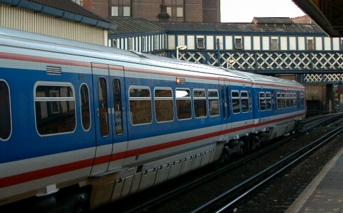 This set
of electric cars were caught at Waterloo East station headed to
Charing Cross station. In southeast England, all the lines are 3rd
rail electrified and most of the equipment is electric. These cars
are used primarily for commuter traffic to and from the communities
in southeast England.
This set
of electric cars were caught at Waterloo East station headed to
Charing Cross station. In southeast England, all the lines are 3rd
rail electrified and most of the equipment is electric. These cars
are used primarily for commuter traffic to and from the communities
in southeast England.
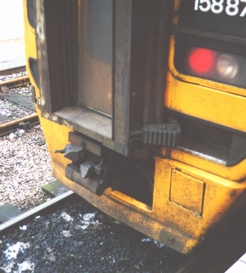 The RDC and electric MU car sets are connected
with a combination coupler and buffer. This arrangement removes all
slack from the consist resulting in very little jerking as the
trains started and stopped. In the case of the RDC's and many of
the 3rd rail electric cars, most of them have a control cab so that
they could run alone if needed. This car has a control cab and a
vestibule so that it can be used in multicar consists as well.
The RDC and electric MU car sets are connected
with a combination coupler and buffer. This arrangement removes all
slack from the consist resulting in very little jerking as the
trains started and stopped. In the case of the RDC's and many of
the 3rd rail electric cars, most of them have a control cab so that
they could run alone if needed. This car has a control cab and a
vestibule so that it can be used in multicar consists as well.
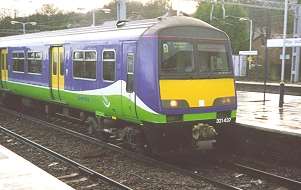 Commuter trains on the lines north were electric but ran
from the overhead catenary. These trains were set up differently.
There were cab cars that could only be used at the end of a train
because there is no vestibule. These cars could control a train but
could not power it.
Commuter trains on the lines north were electric but ran
from the overhead catenary. These trains were set up differently.
There were cab cars that could only be used at the end of a train
because there is no vestibule. These cars could control a train but
could not power it.
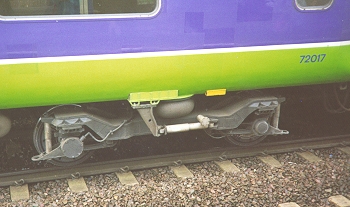 The cab control cars
and regular coaches of these trains ran on unpowered trucks. These
trucks rode extremely well and appear to use a torsion bar as their
primary spring.
The cab control cars
and regular coaches of these trains ran on unpowered trucks. These
trucks rode extremely well and appear to use a torsion bar as their
primary spring.
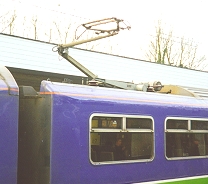 Only one car
in each 4 or 5 car train has a pantograph to pick up power from the
overhead. The roof at one end of these cars was depressed to clear
the pantograph. These power cars did not have control cabs and were
usually found in the center of the train.
Only one car
in each 4 or 5 car train has a pantograph to pick up power from the
overhead. The roof at one end of these cars was depressed to clear
the pantograph. These power cars did not have control cabs and were
usually found in the center of the train.
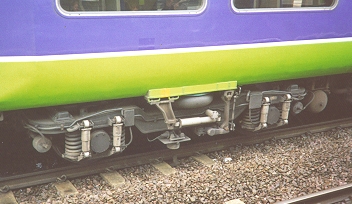 The power car also had
a different truck with heavier springs to accommodate the
significant additional weight of the electrical components and the
traction motors. These cars had the distinctive hum of a
transformer when the train accelerated and didn't ride quite as
well as the other cars, probably due to the stiffer springs.
The power car also had
a different truck with heavier springs to accommodate the
significant additional weight of the electrical components and the
traction motors. These cars had the distinctive hum of a
transformer when the train accelerated and didn't ride quite as
well as the other cars, probably due to the stiffer springs.
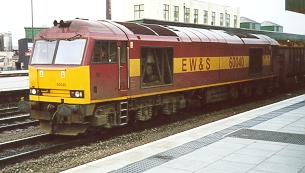 There were a variety of B-B and C-C freight
diesels scattered about. Most of these would run as a single unit
with a relatively short unit train of some kind of freight car.
Single stack containers, coil steel, gondolas and side dump ballast
cars seemed to be the most common. I did see several 4 wheel cars
that appeared to be ore or perhaps coal carriers. Royal Mail unit
trains also ran in with the passenger trains.
There were a variety of B-B and C-C freight
diesels scattered about. Most of these would run as a single unit
with a relatively short unit train of some kind of freight car.
Single stack containers, coil steel, gondolas and side dump ballast
cars seemed to be the most common. I did see several 4 wheel cars
that appeared to be ore or perhaps coal carriers. Royal Mail unit
trains also ran in with the passenger trains.
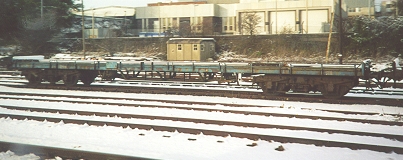 This lonely flat car was about the only piece of general
freight equipment that I saw in the whole trip. It looks pretty
similar to an older US style car.
This lonely flat car was about the only piece of general
freight equipment that I saw in the whole trip. It looks pretty
similar to an older US style car.
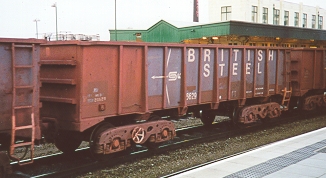 I saw several unit trains of gondolas near Crewe. There
was a British Steel facility near there as well. These cars use a
sort of hook and loop coupler arrangement. There is a hook on each
car and an adjustable loop is locked over the hooks. Slack is
controlled by the sprung buffers on the cars and the locos.
I saw several unit trains of gondolas near Crewe. There
was a British Steel facility near there as well. These cars use a
sort of hook and loop coupler arrangement. There is a hook on each
car and an adjustable loop is locked over the hooks. Slack is
controlled by the sprung buffers on the cars and the locos.
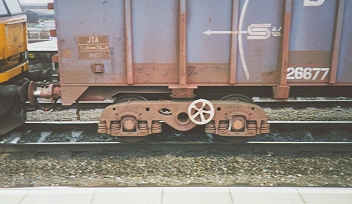 The trucks on these cars look a little odd to an
American eye. The axles are individually sprung and the hand brake
wheel is mounted right on the truck. I saw several other designs of
freight trucks, but these were the only ones that I got a good
picture of.
The trucks on these cars look a little odd to an
American eye. The axles are individually sprung and the hand brake
wheel is mounted right on the truck. I saw several other designs of
freight trucks, but these were the only ones that I got a good
picture of.
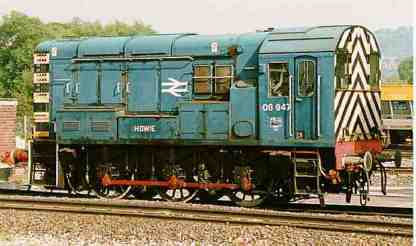 I saw about 20 of these 350 hp English Electric Class 08
"shunters" scattered throughout England. However, I didn't get a
good picture of any of them. This photo from Railways On Line is used with
permission. There were over 200 of these locos built, many of them
are still in service after more than 40 years.
I saw about 20 of these 350 hp English Electric Class 08
"shunters" scattered throughout England. However, I didn't get a
good picture of any of them. This photo from Railways On Line is used with
permission. There were over 200 of these locos built, many of them
are still in service after more than 40 years.
© 2000 George Schreyer
Created Jan 13, 2000
Last Updated Jan 13, 1999
 Many of the high speed intercity
passenger trains that ran in the overhead electrified territory
were powered by a single electric loco. This unit apparently has
plenty of power as it was able to accelerate 8 or more coaches
quite quickly. At the other end of the train would usually be found
a combination cab control/baggage car. At a glance, this car looked
like some of the diesel units, but it was missing the smoke and
noise.
Many of the high speed intercity
passenger trains that ran in the overhead electrified territory
were powered by a single electric loco. This unit apparently has
plenty of power as it was able to accelerate 8 or more coaches
quite quickly. At the other end of the train would usually be found
a combination cab control/baggage car. At a glance, this car looked
like some of the diesel units, but it was missing the smoke and
noise. Diesel powered high speed intercity
passenger trains were usually powered by a unit at both ends of the
train. Even with two units, these trains didn't seem to pull out of
the stations as quickly as the electric trains.
Diesel powered high speed intercity
passenger trains were usually powered by a unit at both ends of the
train. Even with two units, these trains didn't seem to pull out of
the stations as quickly as the electric trains. Intercity trains run between major
cities at very high speeds. However, there were many "local" trains
running that maybe got to 60 or 70 mph and stopped much more often.
Most of these trains are MU self powered cars, some electric, some
diesel. This set is a Wales & West "Alphaline" train composed
of diesel powered cars. These train usually ran in two car consists
with a control cab at either end.
Intercity trains run between major
cities at very high speeds. However, there were many "local" trains
running that maybe got to 60 or 70 mph and stopped much more often.
Most of these trains are MU self powered cars, some electric, some
diesel. This set is a Wales & West "Alphaline" train composed
of diesel powered cars. These train usually ran in two car consists
with a control cab at either end. On our move
from London to Cardiff, it was quite cold and it had snowed the
night before in southern England. Even 3" or so of snow was enough
to snarl the highway system, but the trains were essentially
unaffected.
On our move
from London to Cardiff, it was quite cold and it had snowed the
night before in southern England. Even 3" or so of snow was enough
to snarl the highway system, but the trains were essentially
unaffected. This set
of electric cars were caught at Waterloo East station headed to
Charing Cross station. In southeast England, all the lines are 3rd
rail electrified and most of the equipment is electric. These cars
are used primarily for commuter traffic to and from the communities
in southeast England.
This set
of electric cars were caught at Waterloo East station headed to
Charing Cross station. In southeast England, all the lines are 3rd
rail electrified and most of the equipment is electric. These cars
are used primarily for commuter traffic to and from the communities
in southeast England. The RDC and electric MU car sets are connected
with a combination coupler and buffer. This arrangement removes all
slack from the consist resulting in very little jerking as the
trains started and stopped. In the case of the RDC's and many of
the 3rd rail electric cars, most of them have a control cab so that
they could run alone if needed. This car has a control cab and a
vestibule so that it can be used in multicar consists as well.
The RDC and electric MU car sets are connected
with a combination coupler and buffer. This arrangement removes all
slack from the consist resulting in very little jerking as the
trains started and stopped. In the case of the RDC's and many of
the 3rd rail electric cars, most of them have a control cab so that
they could run alone if needed. This car has a control cab and a
vestibule so that it can be used in multicar consists as well. Commuter trains on the lines north were electric but ran
from the overhead catenary. These trains were set up differently.
There were cab cars that could only be used at the end of a train
because there is no vestibule. These cars could control a train but
could not power it.
Commuter trains on the lines north were electric but ran
from the overhead catenary. These trains were set up differently.
There were cab cars that could only be used at the end of a train
because there is no vestibule. These cars could control a train but
could not power it. The cab control cars
and regular coaches of these trains ran on unpowered trucks. These
trucks rode extremely well and appear to use a torsion bar as their
primary spring.
The cab control cars
and regular coaches of these trains ran on unpowered trucks. These
trucks rode extremely well and appear to use a torsion bar as their
primary spring. Only one car
in each 4 or 5 car train has a pantograph to pick up power from the
overhead. The roof at one end of these cars was depressed to clear
the pantograph. These power cars did not have control cabs and were
usually found in the center of the train.
Only one car
in each 4 or 5 car train has a pantograph to pick up power from the
overhead. The roof at one end of these cars was depressed to clear
the pantograph. These power cars did not have control cabs and were
usually found in the center of the train. The power car also had
a different truck with heavier springs to accommodate the
significant additional weight of the electrical components and the
traction motors. These cars had the distinctive hum of a
transformer when the train accelerated and didn't ride quite as
well as the other cars, probably due to the stiffer springs.
The power car also had
a different truck with heavier springs to accommodate the
significant additional weight of the electrical components and the
traction motors. These cars had the distinctive hum of a
transformer when the train accelerated and didn't ride quite as
well as the other cars, probably due to the stiffer springs. There were a variety of B-B and C-C freight
diesels scattered about. Most of these would run as a single unit
with a relatively short unit train of some kind of freight car.
Single stack containers, coil steel, gondolas and side dump ballast
cars seemed to be the most common. I did see several 4 wheel cars
that appeared to be ore or perhaps coal carriers. Royal Mail unit
trains also ran in with the passenger trains.
There were a variety of B-B and C-C freight
diesels scattered about. Most of these would run as a single unit
with a relatively short unit train of some kind of freight car.
Single stack containers, coil steel, gondolas and side dump ballast
cars seemed to be the most common. I did see several 4 wheel cars
that appeared to be ore or perhaps coal carriers. Royal Mail unit
trains also ran in with the passenger trains. This lonely flat car was about the only piece of general
freight equipment that I saw in the whole trip. It looks pretty
similar to an older US style car.
This lonely flat car was about the only piece of general
freight equipment that I saw in the whole trip. It looks pretty
similar to an older US style car. I saw several unit trains of gondolas near Crewe. There
was a British Steel facility near there as well. These cars use a
sort of hook and loop coupler arrangement. There is a hook on each
car and an adjustable loop is locked over the hooks. Slack is
controlled by the sprung buffers on the cars and the locos.
I saw several unit trains of gondolas near Crewe. There
was a British Steel facility near there as well. These cars use a
sort of hook and loop coupler arrangement. There is a hook on each
car and an adjustable loop is locked over the hooks. Slack is
controlled by the sprung buffers on the cars and the locos. The trucks on these cars look a little odd to an
American eye. The axles are individually sprung and the hand brake
wheel is mounted right on the truck. I saw several other designs of
freight trucks, but these were the only ones that I got a good
picture of.
The trucks on these cars look a little odd to an
American eye. The axles are individually sprung and the hand brake
wheel is mounted right on the truck. I saw several other designs of
freight trucks, but these were the only ones that I got a good
picture of. I saw about 20 of these 350 hp English Electric Class 08
"shunters" scattered throughout England. However, I didn't get a
good picture of any of them. This photo from
I saw about 20 of these 350 hp English Electric Class 08
"shunters" scattered throughout England. However, I didn't get a
good picture of any of them. This photo from